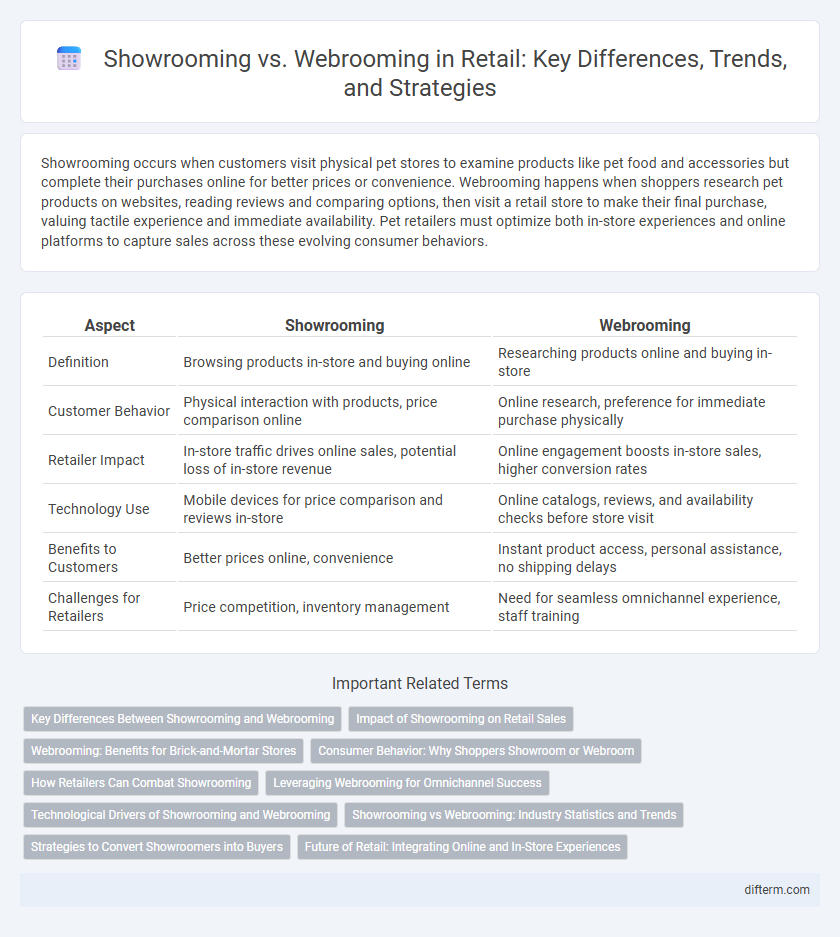Showrooming occurs when customers visit physical pet stores to examine products like pet food and accessories but complete their purchases online for better prices or convenience. Webrooming happens when shoppers research pet products on websites, reading reviews and comparing options, then visit a retail store to make their final purchase, valuing tactile experience and immediate availability. Pet retailers must optimize both in-store experiences and online platforms to capture sales across these evolving consumer behaviors.
Table of Comparison
| Aspect | Showrooming | Webrooming |
|---|---|---|
| Definition | Browsing products in-store and buying online | Researching products online and buying in-store |
| Customer Behavior | Physical interaction with products, price comparison online | Online research, preference for immediate purchase physically |
| Retailer Impact | In-store traffic drives online sales, potential loss of in-store revenue | Online engagement boosts in-store sales, higher conversion rates |
| Technology Use | Mobile devices for price comparison and reviews in-store | Online catalogs, reviews, and availability checks before store visit |
| Benefits to Customers | Better prices online, convenience | Instant product access, personal assistance, no shipping delays |
| Challenges for Retailers | Price competition, inventory management | Need for seamless omnichannel experience, staff training |
Key Differences Between Showrooming and Webrooming
Showrooming involves customers visiting physical retail stores to examine products before purchasing them online, often benefiting from lower online prices and a wider selection. Webrooming refers to consumers researching products online and then buying them in-store, seeking immediate ownership and personalized service. The key differences lie in the purchase channel and customer motivation: showrooming emphasizes online purchasing after in-person evaluation, while webrooming prioritizes offline purchasing following digital research.
Impact of Showrooming on Retail Sales
Showrooming significantly impacts retail sales by driving consumers to visit physical stores to examine products but complete purchases online, often at lower prices. This behavior challenges brick-and-mortar retailers to enhance in-store experiences and implement competitive pricing strategies to retain customers. Retailers leveraging omnichannel approaches can mitigate showrooming effects by integrating online and offline channels for seamless shopping experiences.
Webrooming: Benefits for Brick-and-Mortar Stores
Webrooming drives customers to physical stores by allowing them to research products online before making in-person purchases, increasing foot traffic and conversion rates for brick-and-mortar retailers. This behavior enhances customer trust through tactile experience and immediate product availability, which often reduces return rates. Retailers benefit from higher average transaction values and personalized service opportunities, strengthening brand loyalty and long-term customer relationships.
Consumer Behavior: Why Shoppers Showroom or Webroom
Shoppers engage in showrooming to physically examine products and compare prices online for better deals, driven by a desire for convenience and cost savings. Webrooming appeals to consumers who research products extensively online before purchasing in-store to ensure product authenticity, immediate availability, and personalized service. These behaviors reflect evolving consumer priorities emphasizing price transparency, trust, and seamless multichannel shopping experiences in the retail landscape.
How Retailers Can Combat Showrooming
Retailers can combat showrooming by integrating seamless omnichannel experiences that encourage customers to complete purchases in-store through personalized promotions and exclusive product availability. Leveraging in-store technology such as augmented reality and mobile apps enhances customer engagement, reducing the likelihood of customers leaving to buy online. Employing loyalty programs that reward both online and offline shopping helps retain customers and drives repeat business.
Leveraging Webrooming for Omnichannel Success
Leveraging webrooming enhances omnichannel retail by allowing customers to research products online before purchasing in-store, which boosts in-store traffic and conversion rates. Retailers optimize webrooming by integrating detailed online product information, real-time inventory updates, and personalized promotions that align with in-store experiences. This strategic approach increases customer engagement, drives higher average order values, and strengthens brand loyalty across digital and physical channels.
Technological Drivers of Showrooming and Webrooming
Technological drivers of showrooming include widespread mobile internet access, advanced product comparison apps, and augmented reality tools that enhance in-store exploration while enabling instant price checks online. Webrooming is propelled by sophisticated e-commerce platforms offering personalized recommendations, seamless user interfaces, and integrated social proof systems that encourage pre-purchase research before visiting physical stores. Both behaviors leverage real-time data analytics and AI-powered solutions to optimize consumer decision-making and bridge digital and physical retail experiences.
Showrooming vs Webrooming: Industry Statistics and Trends
Consumers engaging in showrooming examine products in physical stores but complete purchases online, with recent studies showing that 46% of shoppers frequently use this behavior, driven by price comparison and convenience. Webrooming, where customers research products online but buy in-store, accounts for approximately 43% of retail purchases, reflecting a preference for tactile experience and immediate product availability. Retailers adapt by integrating omnichannel strategies, optimizing in-store technology, and enhancing online platforms to capture and convert both showroomers and webroomers effectively.
Strategies to Convert Showroomers into Buyers
Retailers can convert showroomers into buyers by integrating seamless in-store digital experiences, such as interactive kiosks and mobile apps that offer personalized product recommendations and exclusive online discounts. Implementing real-time inventory visibility and flexible purchasing options, like buy-online-pickup-in-store (BOPIS), enhances convenience and reduces friction in the path to purchase. Training sales associates to engage showroomers with knowledgeable product demonstrations and tailored assistance increases the likelihood of closing sales during their in-store visits.
Future of Retail: Integrating Online and In-Store Experiences
Showrooming drives consumers to explore products in-store before purchasing online, while webrooming prompts buyers to research online prior to making in-store purchases. The future of retail hinges on seamlessly integrating these behaviors through omnichannel strategies that leverage data analytics, personalized experiences, and unified inventory management. Retailers adopting augmented reality (AR) and AI-powered tools enhance both digital and physical touchpoints, delivering a cohesive customer journey that bridges online convenience with tactile engagement.
showrooming vs webrooming Infographic

 difterm.com
difterm.com